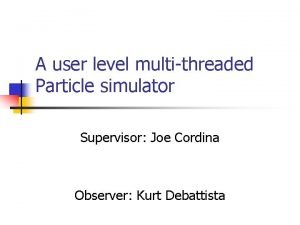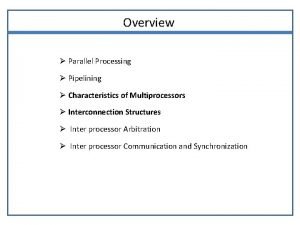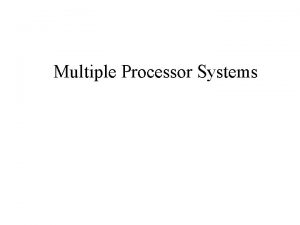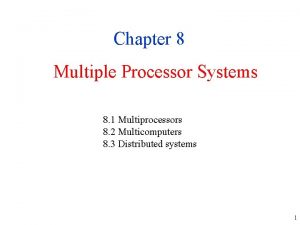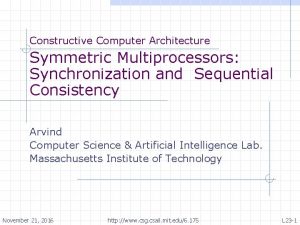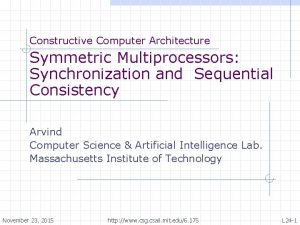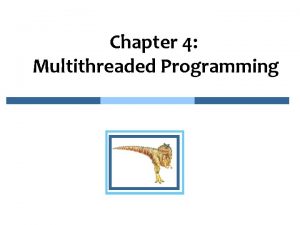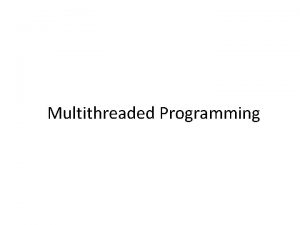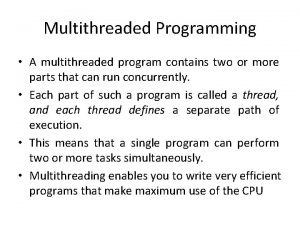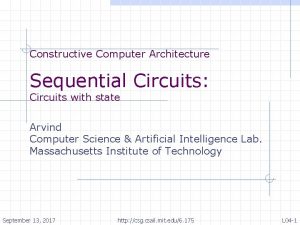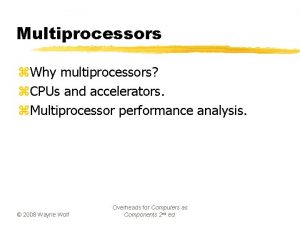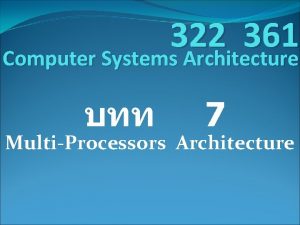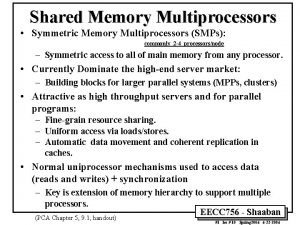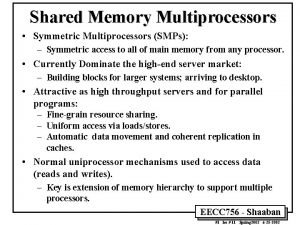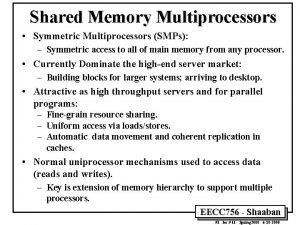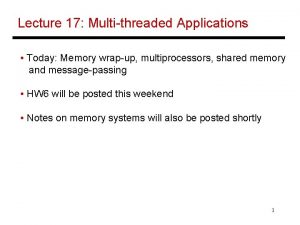Constructive Computer Architecture Multiprocessors Multithreaded Programming and Sequential
























- Slides: 24

Constructive Computer Architecture Multiprocessors: Multithreaded Programming and Sequential Consistency Arvind Computer Science & Artificial Intelligence Lab. Massachusetts Institute of Technology November 13, 2017 http: //www. csg. csail. mit. edu/6. 175 L 21 -1

Symmetric Multiprocessors Processor + cache Processor-Memory Interconnect bridge Memory I/O Interconnect I/O controller All memory is equally accessible to all processors Any processor can do any I/O operation November 13, 2017 I/O controller Graphics output http: //www. csg. csail. mit. edu/6. 175 Networks L 21 -2

Minions Processor + cache Processor-Memory Interconnect bridge Memory I/O Interconnect In modern Systems-on-a-Chip (So. C) there are many processors to perform specific functions; they are programmed in an ad-hoc manner November 13, 2017 minions Proc + Mem Graphics output http: //www. csg. csail. mit. edu/6. 175 Networks L 21 -3

Multithreaded Programming Multiple independent sequential threads which compete for shared resources such as memory and I/O devices n n usually managed by the operating system OS often runs multiple threads for efficient management of resources even on a single processor Multiple cooperating sequential threads, which communicate via the shared memory system, i. e. , shared data structures n an application can often be completed faster by decomposing it into multiple threads and running them on multiprocessors November 13, 2017 http: //www. csg. csail. mit. edu/6. 175 L 21 -4

Synchronization Need for synchronization arises whenever there are parallel processes in a system n Forks and Joins: A parallel process may want to wait until several events have occurred fork P 2 P 1 join n n Producer-Consumer: A consumer process must wait until the producer process has produced data Mutual Exclusion: Operating system has to ensure that a resource is used by only one process at a given time November 13, 2017 http: //www. csg. csail. mit. edu/6. 175 producer consumer L 21 -5

Thread-safe programming Multithreaded programs can be executed on a uniprocessor by timesharing n Each thread is executed for a while (timer interrupt) and then the OS switches to another thread, repeatedly Thread-safe multithreaded programs behave the same way regardless of whether they are executed on multiprocessors or a single processor In the rest of lecture we will assume that each thread has its own processor to run November 13, 2017 http: //www. csg. csail. mit. edu/6. 175 L 21 -6

Producer-Consumer communicate via a FIFO Example: Producer tail head Consumer Rtail Rhead R Assume unbounded FIFO Producer posting Item x: Consumer: Load Rtail, tail Load Rhead, head Store (Rtail), x src addr spin: Load Rtail, tail dest addr R =R +1 if Rhead==Rtail goto spin tail in a reg Store tail, Rtail Load R, (Rhead) Rhead=Rhead+1 dest addr Store head, Rhead process(R) November 13, 2017 http: //www. csg. csail. mit. edu/6. 175 L 21 -7

Multithreaded programming is subtle: An incorrect version Producer tail head Consumer Rtail Rhead R Producer posting Item x: Load Rtail, tail Store (Rtail), x Rtail’=Rtail+1 Store tail, Rtail’ Consumer: Load Rhead, head spin: Load Rtail, tail if Rhead==Rtail goto spin Load R, (Rhead) Rhead=Rhead+1 Store head, Rhead reordering the stores can cause process(R) the consumer to see stale data November 13, 2017 http: //www. csg. csail. mit. edu/6. 175 L 21 -8

Multiple Consumers Producer tail head Rtail Consumer 2 Producer posting Item x: Load Rtail, tail Store (Rtail), x Rtail=Rtail+1 Store tail, Rtail What is wrong with this code? Critical section: The same item may get atomically consumed Needs to be executed by one bothconsumers! locks by November 13, 2017 Consumer 1 Rhead R Rtail Consumer: Load Rhead, head spin: Load Rtail, tail if Rhead==Rtail goto spin Load R, (Rhead) Rhead=Rhead+1 Store head, Rhead process(R) http: //www. csg. csail. mit. edu/6. 175 L 21 -9

Locks or Semaphores E. W. Dijkstra, 1965 Process i acquire(s) <critical section> release(s) The execution of the critical section is protected by lock s; Only one process can hold the lock at a time Lock s has two values: n n Unlocked (s=0): means that no process has the lock Locked (s=1): means that exactly one process has the lock and it can access the critical section Once a process successfully acquires a lock, it executes the critical section and then sets s to zero by releasing the lock Implementing locks is quite difficult; ISAs provide special atomic instructions to implement locks November 13, 2017 http: //www. csg. csail. mit. edu/6. 175 L 21 -10

atomic read-modify-write instructions m is a memory location, R is a register Test&Set m, R: R M[m]; if R==0 then M[m] 1; Swap m, R: Rt M[m]; M[m] R; R Rt; November 13, 2017 Location m can be set to one only if it contains a zero; the old value is returned in R Location m is first read and then set to the new value; the old value is returned in R http: //www. csg. csail. mit. edu/6. 175 L 21 -11

Multiple Consumers Example using the Test&Set Instruction A consumer acquires the lock (mutex) before reading the head value lock: Test&Set mutex, Rtemp if (Rtemp=1) goto lock Load Rhead, head spin: Load Rtail, tail Critical if Rhead==Rtail goto spin Section Load R, (Rhead) Rhead=Rhead+1 Store head, Rhead unlock: Store mutex, 0 process(R) Every thing stops – more sophisticated programming is What if the process stops needed to deal with such or is swapped out while in eventualities the critical section? November 13, 2017 http: //www. csg. csail. mit. edu/6. 175 L 21 -12

Implementation Issues Our example was written assuming that the instructions are executed in order n An architecture may execute instructions out of order to gain higher performance Gives rise to memory model issues Atomic instructions (read-modify-write) are quite disruptive in pipelined machines November 13, 2017 http: //www. csg. csail. mit. edu/6. 175 L 21 -13

Sequential Consistency A Memory Model P P P M “A system is sequentially consistent if the result of any execution is the same as if the operations of all the processors were executed in some sequential order, and the operations of each individual processor appear in the order specified by the program” Leslie Lamport Sequential Consistency = arbitrary order-preserving interleaving of memory references of sequential programs November 13, 2017 http: //www. csg. csail. mit. edu/6. 175 L 21 -14

Sequential Consistency Sequential concurrent tasks: T 1, T 2 Shared variables: X, Y (initially X = 0, Y = 0) T 1: Store X, 1 Store Y, 2 (X = 1) (Y = 2) T 2: Load R 1, Y Store Y’, R 1 Load R 2, X Store X’, R 2 (Y’= Y) (X’= X) what are the legitimate answers for X’ and Y’ ? (X’, Y’) {(1, 2), (0, 0), (1, 0), (0, 2)} ? If y is 2 then x cannot be 1 November 13, 2017 http: //www. csg. csail. mit. edu/6. 175 L 21 -15

Why SC may be violated Sequential consistency imposes more memory ordering constraints than those imposed by uniprocessor program dependencies ( ) What are these in our example ? additional SC requirements ( T 1: T 2: Store X, 1 (X = 1) Load R 1, Y Store Y, 2 (Y = 2) Store Y’, R 1 (Y’= Y) Load R 2, X Store X’, R 2 (X’= X) ) High-performance processor implementations often violate SC by not enforcing the extra dependencies required by SC Example Store Buffers November 13, 2017 http: //www. csg. csail. mit. edu/6. 175 L 21 -16

Store Buffers A processor considers a Store to have been executed as soon as it is stored in the Store buffer, that is, before it is put in memory A load can read values from the local store buffer (forwarding) Loads/Stores can appear to be ordered differently to other processors ==> violate SC P P Memory Some systems only enforce FIFO ordering for the stores to the same address while moving a store from store buffer to memory November 13, 2017 http: //www. csg. csail. mit. edu/6. 175 L 21 -17

Violations of SC Example 1 Process 1 Store flag 1, 1; Load r 1, flag 2; Process 2 Store flag 2, 1; Load r 2, flag 1; Question: Is it possible that r 1=0 and r 2=0? • Sequential consistency: No • Suppose Stores don’t leave the store buffers before Yes ! the Loads are executed: Initially, all memory locations contain zeros November 13, 2017 http: //www. csg. csail. mit. edu/6. 175 L 21 -18

Violations of SC Example 2: Non-FIFO Store buffers Process 1 Process 2 Store a, 1; Store flag, 1; Load r 1, flag; Load r 2, a; Question: Is it possible that r 1=1 but r 2=0? • Sequential consistency: No • With non-FIFO store buffers: Yes November 13, 2017 http: //www. csg. csail. mit. edu/6. 175 L 21 -19

A Producer-Consumer Example continued Producer posting Item x: Load Rtail, (tail) 1 Store (Rtail), x Rtail=Rtail+1 Store tail, Rtail 2 Consumer: Load Rhead, head 3 spin: Load Rtail, tail if Rhead==Rtail goto spin Load R, (Rhead) 4 Rhead=Rhead+1 Store head, Rhead Can the tail pointer get updated process(R) before the item x is stored? Programmer assumes that if 3 happens after 2, then 4 happens after 1. Problem sequences: 2, 3, 4, 1, 2, 3 November 13, 2017 http: //www. csg. csail. mit. edu/6. 175 L 21 -20

Memory Fences Instructions to sequentialize memory accesses Processors which do not support SC memory model provide memory fence instructions to force the serialization of memory accesses as needed Consumer: Load Rhead, (head) spin: Load Rtail, (tail) if Rhead==Rtail goto spin Fence. LL Load R, (Rhead) Rhead=Rhead+1 Store head, Rhead ensures that R is process(R) not loaded before x has been stored Producer posting Item x: Load Rtail, (tail) Store (Rtail), x Fence. SS Rtail=Rtail+1 Store tail, Rtail ensures that tail ptr is not updated before x has been stored RISC-V has one instruction called “fence” November 13, 2017 http: //www. csg. csail. mit. edu/6. 175 L 21 -21

SC and caches Caches present a similar problem as store buffers – stores in one cache will not be visible to other caches automatically Cache problem is solved differently – caches are kept coherent P P Cache Memory How to build coherent caches is the topic of the next lecture November 13, 2017 http: //www. csg. csail. mit. edu/6. 175 L 21 -22

TSO: A memory model for machines with store buffers St a v Processor Reg state <a, v> Store buffer <a, v> … Processor Reg state Store buffer simple and vendor independent Monolithic memory A store first goes into the Store buffer (SB) A load reads the youngest corresponding entry from SB before reading the memory per address PSO A store is dequeued from the SB in FIFO order to update the monolithic memory (background rule) A commit fence stalls local execution until SB is empty TSO allows loads to overtake stores November 13, 2017 http: //www. csg. csail. mit. edu/6. 175 L 21 -23

Memory Model Issue Architectural optimizations that are correct for uniprocessors, often violate sequential consistency and result in a new memory model for multiprocessors Memory model issues are subtle and contentious n n x 86 ISA uses TSO, whose definition is easy to understand unambiguous ISAs for ARM, Power. PC etc. use weaker memory models and even experts don’t agree on their definitions November 13, 2017 http: //www. csg. csail. mit. edu/6. 175 L 21 -24
 Multithreaded programming languages
Multithreaded programming languages Multithreaded programming language
Multithreaded programming language Constructive proof vs non constructive
Constructive proof vs non constructive Constructive proof vs non constructive
Constructive proof vs non constructive Constructive proof vs non constructive
Constructive proof vs non constructive Proof by contradiction examples
Proof by contradiction examples Multithreaded games
Multithreaded games Multithreaded algorithms
Multithreaded algorithms Apt multithreaded
Apt multithreaded Interprocessor arbitration
Interprocessor arbitration Characteristics of vector processing
Characteristics of vector processing Uma multiprocessors using multistage switching networks
Uma multiprocessors using multistage switching networks Multiple processor systems
Multiple processor systems Sequential program and an event-driven program
Sequential program and an event-driven program What is nano programming
What is nano programming Difference between computer organization and architecture
Difference between computer organization and architecture Bus architecture in computer architecture
Bus architecture in computer architecture Design of basic computer with flowchart
Design of basic computer with flowchart Main subroutine architecture
Main subroutine architecture Batch sequential architecture
Batch sequential architecture Perbedaan linear programming dan integer programming
Perbedaan linear programming dan integer programming Greedy programming vs dynamic programming
Greedy programming vs dynamic programming System programming definition
System programming definition Integer programming vs linear programming
Integer programming vs linear programming Definisi linear
Definisi linear








